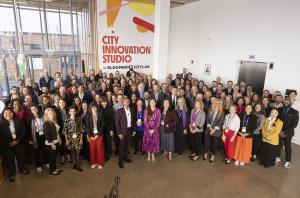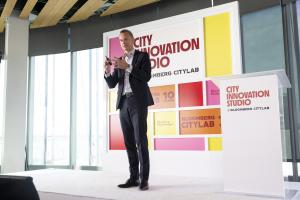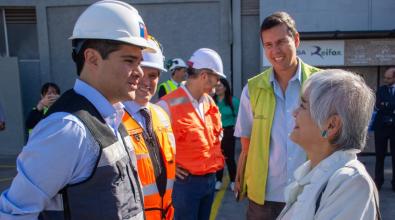 Read More
Read More
Strategies for tackling complex city challenges

The challenges faced by today's cities—from migration to homelessness to climate-related infrastructure vulnerabilities—are so complex, cross-sectoral, and constantly changing that it's increasingly difficult for city leaders to fully address them.
That's why last month's City Innovation Studio (CIS) brought together more than 100 local innovation, infrastructure, and data leaders at Bloomberg CityLab in Washington, D.C., to take a deep dive into systems-change strategies, tools, and approaches that enable city halls to move beyond the surface—and to the root causes—of their biggest challenges. The discussion was fueled by insight and expertise from the Bloomberg Center for Public Innovation at Johns Hopkins University and Danish innovation expert Christian Bason.
Raise and sustain an ambitious vision for the future.
Successful transformation starts by raising and sustaining an ambitious vision for change. That should include a shift in focus, from the problems before you to the opportunities for impact. It also requires engagement with stakeholders throughout the community—inside and outside government—to define long-term goals and, importantly, build support for those goals that can outlive any political term. By bringing together these people, along with their unique experiences and priorities, cities can create a unified vision for the intended change that both outlines the direction and nature of the work ahead and illustrates how the world will look and work differently once that change is in place.
As Bason explained, the first crucial question here is, “What's the dream?” And, after that, and more precisely: “What's the practical situation?”
In Charlotte, N.C., the city recognized a need to take a new approach to creating safe, prosperous communities for residents in the wake of a 2014 study that ranked the city last among the country's largest metro areas in terms of social mobility. According to Innovation and Data Officer Andrew Bowen, in the wake of that report “Charlotte leaders came together and said, 'You know what, this was a generational study. It identified generational problems that need to be addressed. And addressing those generational issues requires focus on equity—and of course sustainability.'” This new generational focus was one of the drivers behind the city's 2040 Comprehensive Plan, passed in 2021, which created a community vision plan to frame solutions to the problems at hand.
One of the ways this new focus is manifesting itself in Charlotte is in a $72-million Corridors of Opportunity Initiative that addresses affordable housing, community safety, infrastructure, and workforce and business development in six key corridors throughout the city. The project's many efforts are backboned by partnerships—between public infrastructure teams, the community, and non-profit and private-sector organizations—that not only help sustain capital and programmatic investment, but also set up a process to identify the communities to invest in next.
Undertake meaningful collaboration to maximize impact.
The problems cities face are rarely “owned” by any single stakeholder. Instead, a slew of local and regional actors—each with their own causes and priorities—can be tapped for unique perspective and expertise. The opportunity, then, is to create a space for open conversations, where stakeholders learn from each other and new partnerships and cooperation thrive.
In Kansas City, Mo., City Manager Brian Platt has worked to navigate the competing egos and agendas of a wide variety of local voices as his city prioritizes street safety, through a Vision Zero program, and looks to tackle more existential problems like climate. Among the recent initiatives to spring out of this larger effort was a sidewalk rubberization program. “The things we are doing are with our communities, not for them,” he said.
Likewise, Harvard University urban planning professor Toni L. Griffin described how, when she helped lead Washington, D.C.'s planning department, the city took an approach at rebuilding the Anacostia River Waterfront that was laser-focused on community participation. That helped ensure the plan reflected the needs of the community—including affordable housing and business opportunities—and demonstrated that it wasn't only the city government that was invested in the project. This strategic and deliberate approach at collaboration, Griffin said, is one that community organizations throughout the city continue to proudly reference two decades later. That's because it reflects their work, she explained. “Their fingerprints are on it.”
Employ a portfolio approach to ensure progress on multiple fronts.
Once cities have dynamic solutions to community-defined problems—and opportunities—in mind, a portfolio approach can take their work to another level. This typically means employing a large menu of interventions and multiple funding sources, as well as ongoing resource mobilization—all backed up by data to keep tabs on results and create loops of learning.
As Bason explained: “We use the word intervention rather than project, because a portfolio can consist of many different activities: campaigns, policies, regulations, and on-the-ground projects with communities and partners in a very tangible way.” Also, he added, “a portfolio approach means that we need to do more than one project.”
Leaders in Fortaleza, Brazil provide a model for this work: They did not want to just throw a couple of incremental investments at a problem as imposing as climate change, but instead were determined to attack it from every angle, with every type of resource at their disposal. That meant designing a series of interventions that included a Bloomberg Initiative for Cycling Infrastructure award-winning development of 180 kilometers of new bike infrastructure, new parks and green areas, and a fresh approach to waste management aimed at achieving a 50 percent recycling rate by 2030 in a city where waste has accounted for a quarter of carbon emissions.
This diverse, portfolio approach hasn't just helped Fortaleza make progress in the face of climate change, it's created a culture change in the way the city works, according to Fortaleza's Director of the City Observatory, Elis Teixeira. That means city leaders aren't only tracking progress and looking for lessons along the way, they're also “transforming information into actionable insights that guide ongoing policies” and, importantly, opening the door to even more innovations.



